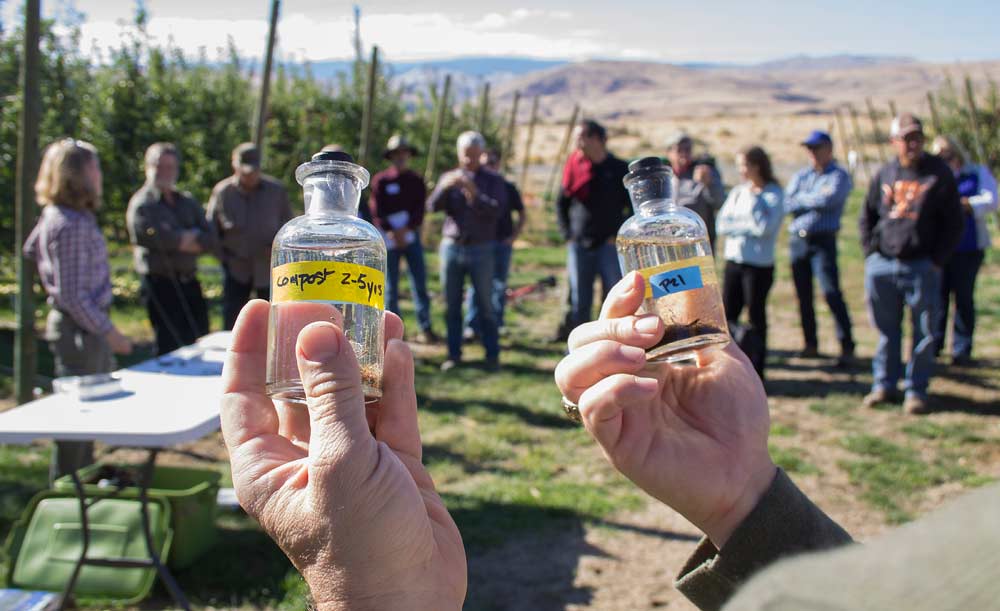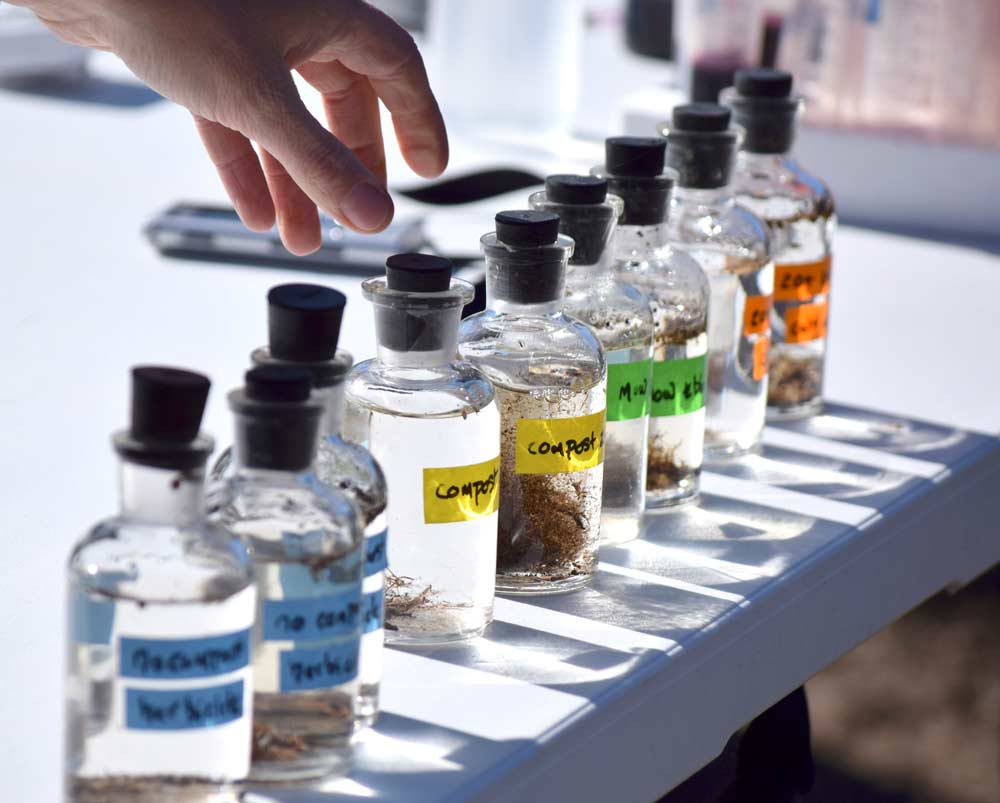
An attendee at a Washington State University orchard floor management workshop, held at the university’s Sunrise Orchard near Quincy, Washington, last fall, examines vials of particulate organic matter, one type of active organic matter. (Shannon Dininny/Good Fruit Grower)
The active pool of soil organic matter can be measured in a number of different ways.
Tianna DuPont, a Washington State University regional extension specialist, highlighted two at an orchard floor management workshop at the university’s Sunrise Research Orchard between Quincy and Wenatchee, Washington, last fall.
The first method measures readily oxidizable carbon — primarily the carbohydrates and sugars in the soil that oxidize quickly when reacted with permanganate and which also happen to be the primary food for beneficial microbes in the soil.
To gather the soil samples, DuPont used a soil core and gathered 100 samples from the top 10 inches, then mixed that soil together in a bucket from which to draw subsamples. (Generally, it’s recommended growers take 15 cores per 5 acres.)
DuPont then added half a teaspoon of dry soil to 20 milliliters of a potassium permanganate solution; she then shook the mixture for 2 minutes, then let it sit for 10 minutes.
“The lighter the color, the more of this readily oxidizable carbon there is in that soil, because it’s reacted more with this purple permanganate,” she said.

Washington State University regional extension specialist Tianna DuPont demonstrates methods to measure active carbon in soil. (Shannon Dininny/Good Fruit Grower)
So how might growers change the levels of this readily oxidizable carbon? Feed the soil. Provide organic inputs such as growing plants, plant material, compost, manure and even some pelletized organic amendments.
“When you have more roots, those roots turn over and provide more exudates — sugars and carbohydrates. Roots are really leaky. In order for them to pick up nutrients, they actually leak out a lot of stuff, and that’s food for the soil microbial community,” she said.
Grass clippings from alleyways, prunings, mulches and other plant materials provide carbon.
All of these organic matter inputs generally increase active carbon first, then hopefully, over time, total organic matter, DuPont said.
Tom Forge, research scientist with Agriculture and Agri-Food Canada in Summerland, British Columbia, noted that wood chip mulch breaks down slowly and doesn’t feed microbes very quickly.
But adding something with a little bit more nitrogen, such as compost or manure, can increase the pace.

These vials contain particulate organic matter, one type of active organic matter. By washing soil through a sieve, you are left with the particulate organic matter. In this photo, the vial in the center, which had many years of compost amendments, had higher active organic matter. (Shannon Dininny/Good Fruit Grower)
The best bet, DuPont said, is to think about what to add to the soil to feed microbes right away, as well as the long-term carbon pool that’s going to help build up the total organic matter.
A second active carbon measurement DuPont highlighted involved washing a cupful of soil through a 250-mesh sieve, rinsing water through until it runs clear, and capturing the remaining particulate organic matter. Growers should examine what type of materials remain, as well as how much.
The old methods of measuring organic matter are less sensitive to the active carbon, and the new methods are changing how researchers look at soil health, Forge said. Overall, they help to explain why it’s been difficult in the past to detect a corresponding change in soil organic matter when a horticultural practice is changed.
“By looking at shorter-term things, we can look at these fractions of more active carbon now, and it’s probably going to give us a better indication of how we’re really changing the system,” he said. “It gives us an indication of where we’re headed.” •
– by Shannon Dininny






Leave A Comment